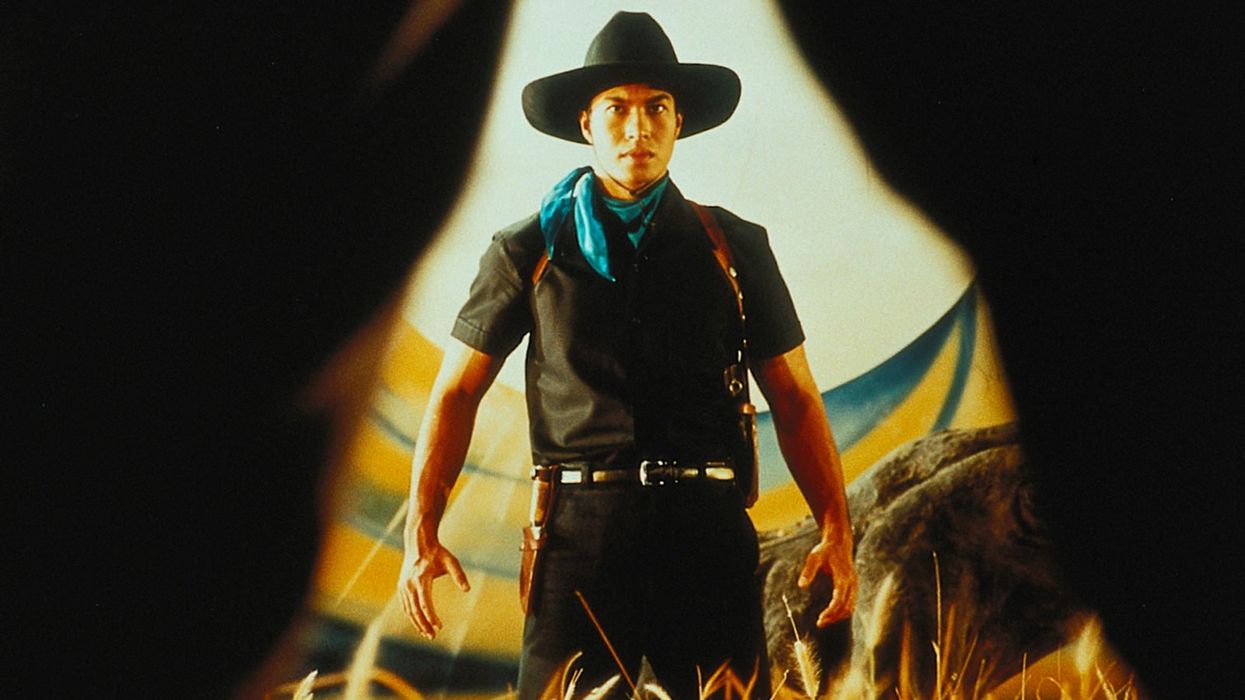
Magnolia Pictures

Spaghetti Westerns have nothing on the bizarre violence and beautiful absurdity of Wisit Sasanatieng's "tom yung goon cowboys."
Bazookas in a Western? You're darn right. Explosions of every kind. Slowed down like a cartoon. And melodrama. Histrionics to the sky. But also flowers, gorgeous color springing to life, sweeping, powerful beauty.
Director Wisit Sasanatieng told journalists: "I wanted the audience to feel like they're reading a novel with moving illustrations. It's pure imagination and completely unrealistic. I wanted to try and go back to our roots. I wanted to make a link between the traditional and the contemporary in our own style."
A first-time Thai director makes the kind of truly artistic B movie America hasn't seen in years.
"Tears of the Black Tiger" was the first movie I ordered from Netflix, back when it was a DVD mail service. I remember the powerful confusion I felt, the enjoyment of witnessing something utterly weird.
The blatantly fake mustaches, the unapologetically sentimental ballads, the squadrons of outlaws, the "Casablanca" stage lighting, noir in radioactive color.
“Tears of the Black Tiger” marks the first Western on this list that is radically different from the first generations of Western films, from all previous generations, really.
Sasanatieng's directorial debut, "Tears of the Black Tiger" was the first Thai movie to appear at the Cannes Film Festival. Since then, the filmmaker's eye for explosive, beautiful, and dramatic imagery, along with his knack for combining tragedy with strange humor, has earned him a spot at the forefront of the Thai New Wave movement — and two releases on Netflix in the past three years.
For all the film's Old West American influences, there are just as many that are distinctly Thai, most of which I admittedly know little about.
One source of inspiration I do recognize is the films of Sergio Leone, right down to the soundtrack. While Leone famously made "spaghetti Westerns," Sasanatieng says his flicks concern “tom yum goong cowboys,” referencing a noodle soup unique to Thailand.
It all adds up to a truly artistic B movie the likes of which America has not seen in many years.
Sasanatieng also cites moody Thai pop ballads, some of which led him to the vision of “a beautiful frame of two guys shooting each other in the rain.”
The boss outlaw is played by legendary Thai actor Sombat Metanee, whose over 600 movie roles once landed him the Guinness World Record for most film appearances.
It’s a remarkably playful movie, with tons of zany experimentation.
Characters behave strangely, often without anyone ever explaining why, carried forward by the manic sweep of the scene change. The images have the uncanny quality of being "off" somehow, like an AI video 25 years before AI.
An unabashed love story mingles with cartoonish violence. Melodramatic emotions flare, while heads and bodies explode like catapulted pumpkins. Severed arms go flying through the air as bandits kill soldiers.
The Winchesters have been replaced by LMGs and grenades and leftover Mauser rifles. There are six-shooters, but their bullets are capable of unprecedented damage.
Anything can happen at any moment. The rules of our universe don’t apply. It’s a mash-up of so many styles, techniques, devices, and influences, all rushing at a gasping pace, that it’s impossible to tell what’s homage and what’s new-fangled, which results in an entirety that’s brand new.
Sasanatieng cultivates this disorientation by running digital video through 35mm film stock, a combination of futurism and classicalism that permeates the entire movie.
"Tears of the Black Tiger" takes the kind of breathtaking landscapes Westerns have always captured and blends them with obvious fabrications.
A boat drifts through a lake of perfect flowers, giant lily pads, and dense thickets of tall grass, transporting characters from one ornamental pavilion to the next, where they discuss rain and love, only to reveal an internally bare backdrop with a pastel rendering of the sun.
Best of all, this ultraviolet spectacle plays out with an unmistakable conviction, even in its more garish, tongue-in-cheek moments, all with a stylistic prowess that even Wes Anderson would envy. No disrespect to Mr. Anderson, but his cerebral schtick would get in the way of this mesmerizing slop show.
It’s a Western refracted through so many translations that everything is only halfway familiar to the genre, like an absurdist dream full of over-serious characters.
It feels low-budget yet decorative and artful at the same time. This Thai film elevates the revisionist Western to unimaginably new heights.
The dialogue can be so poetic at times. Others, it’s belligerent and unreasonable. There’s no way to predict which the next line will be.
Our heroes — one of whom is a dwarf in cowboy garb, another Leone homage, perhaps — are only heroic in relation to the storm-cloud menace of villains who live to kill innocents. In turn, the heroes kill innocents. Before long, there are no real heroes, but everyone is so dramatic that it’s hard to dismiss any of them.
The harmonica-playing Sua Dum (Black Tiger), dressed in all black, was not always so broken and vengeful. We jump around through time in an effort to understand his rage.
But the pace is too fast to attach emotional depth to the storyline, which cycles through more betrayal and death than ten Westerns. This actually adds to the narrative power of the story. There’s something admirable about its refusal to go easy on the plot twists.
It’s over before you know it, leaving you with the vertigo of enjoyment, whiplash from the nonstop action, too much beauty to keep track of, unfolding into a series of fight scenes that would be implausible in even the most satirically violent and excessive video game.